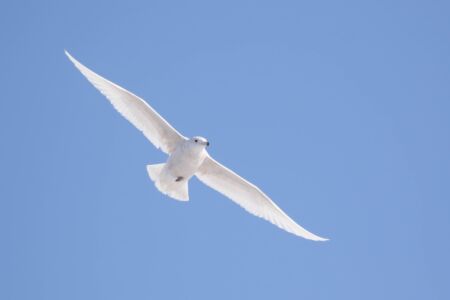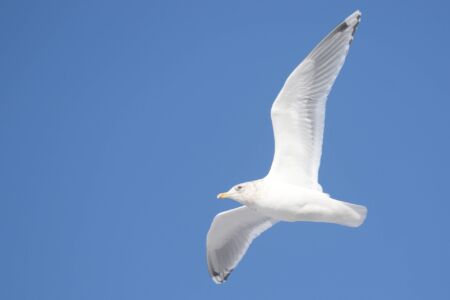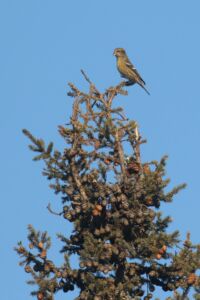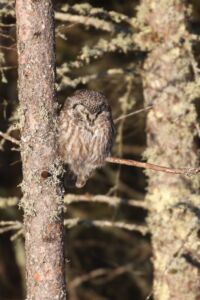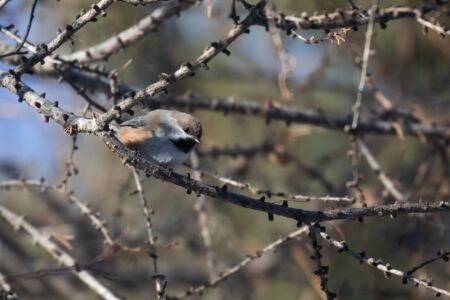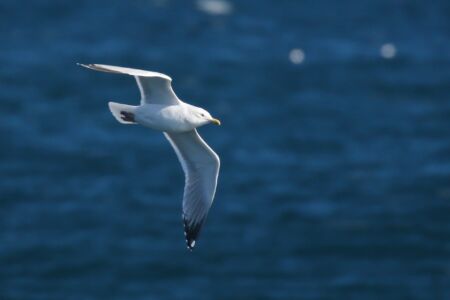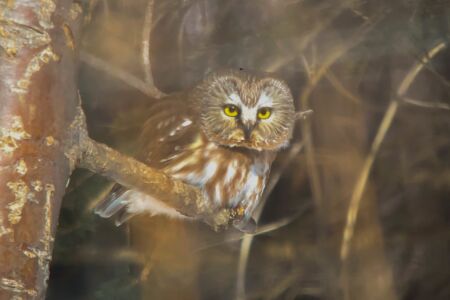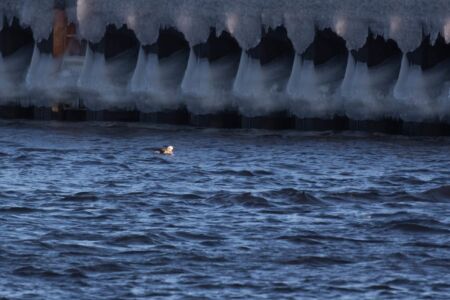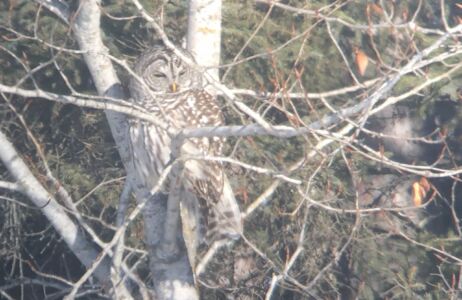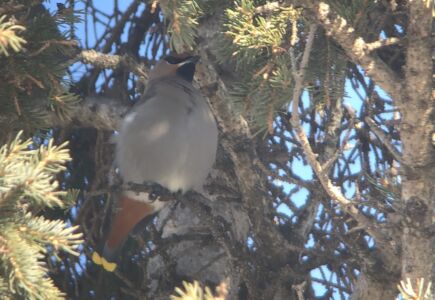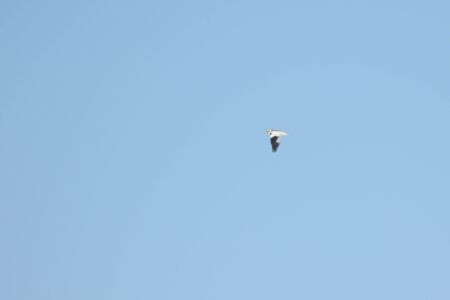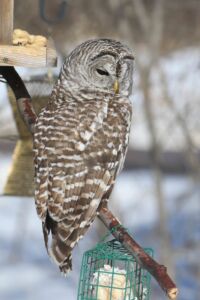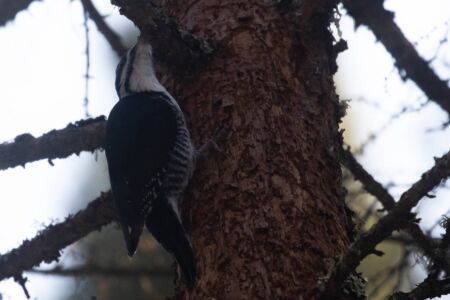TRIP REPORT: MINNESOTA – 2020 February – Winter Boreal Specialties

TOUR FOCUS
TRIP LEADERS
PRIVATE TOUR OPTION
This tour is available as a private trip for any size group. The tour cost will vary with the number of people and any custom requests.
TESTIMONIALS
Trip Report written by Alex Lamoreaux
Day 1 / February 20, 2020

Northern Saw-whet Owl, photo by Alex Lamoreaux
Duluth enjoyed a mild winter; Lake Superior was ice-free and snow levels were moderate to low. Unseasonably warm temperatures and sunny skies greeted us on February 20th, and by noon all clients had arrived in town and we set off birding in two vehicles. Chris Brown and I were leading this year’s tour of the northwoods, and it was sure to be a good one based on recent sightings in the region.
In fact, an incredible sighting had just come in that morning of a Northern Saw-whet Owl hunting above the feeders at Hartley Nature Center! We raced to the nature center right away and were some of the first people on the scene. Sitting right there in front of us (although through a deer-restrictive wire fence) was the tiny owl, perched above the feeders and staring intently at the ground!
After a few minutes, the owl hopped down to perch on a bird-feeder platform and then hovered a few feet off the ground. Clearly the little guy was searching for voles attracted by the spilled seed. After a few minutes he did actually grab a nice Meadow Vole and flew up to a nearby spruce to begin eating it. Feeling a little too exposed and open to harassment by at least 8 Black-capped Chickadees, the saw-whet eventually few back into the woodlot to find a more protected spot for enjoying its lunch.
Northern Saw-whet Owl is rare here in winter, often pushed much further south because deep snow depths don’t allow them to hunt successfully. Kicking off the tour with this unexpected species set us up for a shot at the 7-owl sweep of the region!
One adult Bald Eagle and light type Rough-legged Hawk migrated overhead in the clear, blue skies, further proving the point that spring had come early to northern Minnesota and bird diversity was sure to be higher than average. A Hairy Woodpecker and Eastern Gray Squirrel made brief visits to the feeders and our guests had their first experience with feisty American Red Squirrels!
For many in our group, the saw-whet was the first of many lifers they were going to pick up this week. Satisfied with our first stop, we got back in the cars and drove towards the lake and through downtown Duluth. The clear day offered great views of the massive lake, and it was shocking to see the whole lake open and ice-free.

First-winter Glaucous Gull, photo by Alex Lamoreaux
Our next stop was to the WLSSD (Western Lake Superior Sanitary District) recycling factory right along the lakeshore where many scavenging birds were gathered for free handouts. At least 60 Herring Gulls were flying around or gathered on a large rooftop nearby, and we quickly picked out a half dozen first-winter Glaucous Gulls!
At least 5 Bald Eagles of mixed ages were in sight at once, and we saw our only Red-tailed Hawk of the tour – an adult, and likely Northern (abieticola) subspecies. 60 Rock Pigeons, at least 80 American Crows, and 6 House Sparrows were additional pickups – common, but anything to boost our trip list!
I reminded people that even though we may only end up with 40-60 species for this tour, it was more about quality than quantity. And right now on cue, a seriously quality bird flew directly overhead – an adult “Thayer’s” Iceland Gull! The Thayer’s flew loops above us, and the lighting was perfect for nice photos.

“Thayer’s” Iceland Gull, photo by Alex Lamoreaux
Canal Park was our next stop, and we quickly found three Common Goldeneye in the water there, which offered nice scope-views of this charming duck. More Herring Gulls were flying around and we counted 4 more Bald Eagles. Just before leaving a female Red-breasted Merganser flew past! This vantage point offers a beautiful view of the city of Duluth and Hawk Ridge rising above the northern lakeshore.
From there we set off across the St. Louis River which flows into the western tip of Lake Superior, and crossed into Wisconsin for the afternoon. Our first stop was to the Superior Grain Silos which often attracts waterfowl, and here we found our only two Canada Geese of the tour. We make a quick drive past the Richard I. Bong Airport in search of Snowy Owls, but it was too early in the day yet and all we turned up was a few crows and 3 Bald Eagles.

First-winter Bald Eagle, photo by Alex Lamoreaux
Heading towards Wisconsin Point, we passed the Superior Landfill and picked out our first Common Ravens mixed with Bald Eagles and dozens of Herring Gulls.
Out at Dutchman’s Creekmouth we had another incredibly scenic view of the big lake, and Bald Eagles were plentiful. Chris spotted a Northern Shrike perched right near the cars! It moved on quickly, but we all had nice views.
Heading back past the landfill, we spotted to red type Ruffed Grouse feeding on aspen buds high in a tree. Most guests had views of them, but they quickly flew back into the cover of the forest.
Passing Allouez Bay on our way out Wisconsin Point we spotted more Bald Eagles, and once out to the Superior Entry canal we found 14 Common Mergansers and 1 Red-breasted Merganser floating together. Having any waterfowl around during this time of the year is rare (apart from some Mallards of course), but to already have goldeneye and 2 merganser species was quite unusual – and certainly welcome!
It was getting closer to sunset, so we made our way back towards the airport for another try at Snowy Owl. Along the way we picked out another Northern Shrike perched at the tip of a tall tree overlooking a scrubby area.
A cursory check of the ‘normal’ airport viewpoints once again didn’t turn up any owls, but I ran into a local-birder friend of mine and he gave us a tip on a female type Snowy perched on the lights around the nearby fairgrounds… We shot across the street to check and almost immediately found the owl, right where promised. This was a moderately-marked type Snowy, which had been captured and marked by local researchers. We noted the green wing-tag it had, with the number ’71’ emblazoned on it.
Well satisfied with a full afternoon and some great birds, we crossed back into Minnesota and went off to dinner!

Superior Entry Lighthouse, photo by Alex Lamoreaux
Day 2 / February 21, 2020

Pre-sunrise Snowy Owl, photo by Alex Lamoreaux
For our first full day, we were up early and after a quick stop for ‘Caribou Coffee’ we set off for Sax-Zim Bog. Turning off the highway and into the bog, there was just enough light to make out the shapes of birches and spruces along the road and among them we found a group of 4 Ruffed Grouse feeding on buds high in a tree. We had close view, but it was still pretty dark out so we kept moving.
Our goal was to try some regular spots for Great Gray Owls before the sun came up too much. Along County Road 7 we spotted a Snowy Owl fairly close to the road – it was perched in the tippy-top of a birch and although the lighting wasn’t perfect, it made for interesting photos. We scoped out other spots along CR7 for Great Gray, with no luck, and then continued towards Admiral Road which can be another productive spot.
Turning down Admiral Road it wasn’t long before Chris’s car spotted a single Canada Jay, and we noted Hairy Woodpeckers and Black-capped Chickadees in addition to some wintering European Starlings gathered around an old barn.
Further down the road we stopped at the famous feeder setup, and prepared to spend a bit of time out in the cold to see what was coming to the feeders. A group of photographers was intently shooting something at the feeders, but from our vantage point we could only see a nice assortment of the classic winter feeders birds – Blue Jays, Canada Jays, Red-breasted Nuthatches, Black-capped Chickadees, and some American Red Squirrels. A large flock of 20 ‘Slate-colored’ Dark-eyed Juncos was a surprise, as it is unusual to have *any* juncos here in the winter…another hint towards the mild conditions present in the northwoods this year.
I shuffled over to see what the photographers were up to and immediately noticed the target of their lenses…a BOREAL OWL! This little owl (like an oversized saw-whet, marked like a miniature hawk owl) had been a somewhat regular attendee of these feeders in the weeks before our trip started, but sightings ceased a full 4 days previously and we had pretty much lost hope of seeing this rare bird.
Indeed, this was the rarest of the 7 owls possible…but our 3rd species of the trip! Locals had started calling him ‘Baby Yoda’ which is quite fitting in my opinion. Boreal Owl irruptions happen every 5-1o years. This winter had been better than average, but this was the only cooperative sighting of the season. We were super lucky to spend time in close proximity to this bird, and even if it primarily sat motionless and slept, we enjoyed it thoroughly. A few times it did open it’s eyes to scan the feeder area for rodents, and did some nice leg and wing stretches too!
A great way to kick off the day! Around the same time we spotted the owl, we also noted a nice flock of at least 6 White-winged Crossbills gathering in the nearby spruces – some were even singing!

Boreal Owl, photo by Alex Lamoreaux

Canada Jay along Admiral Road, photo by Alex Lamoreaux
It was hard to walk away from the Boreal Owl, but folks were starting to get cold and it was time to move on. The Boreal Owl was never seen again after this day, and so I feel incredibly lucky that it made a sudden re-appearance, seemingly just for us! We made another pass down CR7 and saw the Snowy Owl again, but this time it was very distant to the west side of the road…just a large white dot in a distant treeline.

Black-billed Magpie, photo by Alex Lamoreaux
We stopped at the Winterberry Bog and made the half-mile jaunt around its snow-covered trails. Footsteps from 100s of other birders previously had padded down a comfortable path through the snowy bog, and we carefully scanned the dense tamaracks for any sign of two special woodpeckers – Black-backed Woodpecker and American Three-toed Woodpecker. Sadly, though, our effort only turned up a handful of Hairy Woodpeckers and a small flock of Pine Siskins.
We cruised through the streets of a small town called Meadowlands in search of a berry-laden Mountain Ash tree I was told about. We found the tree, but the reported Bohemian Waxwings were absent. North of town, we drove up Racek Road.
We had stopped to scan through a large flock of American Crows and Common Ravens, when I spotted a Black-billed Magpie! These charasmatic birds are icons of the American West, but they reach their eastern limit right here at Sax-Zim Bog. We jumped out to try and get better views and within a minute or two we had 3 of them fly directly overhead! Off in the distance I spotted 2 more in flight, in addition to 2 very distant, flying Pileated Woodpeckers! A light type Rough-legged Hawk soared nearby, but never came particularly close.

Ruffed Grouse, photo by Alex Lamoreaux
Cruising up Owl Ave we spotted a single male White-winged Crossbill, and then arrived at the ‘Friends of Sax-Zim Bog’ visitor center for a bathroom break and a look around their gift shop.
The feeders here were very active and we picked out our first American Goldfinches of the tour. Canada Jays were tearing fat off a deer carcass, and Red-breasted Nuthatches were showing off nicely at close range.
Getting towards lunch time, we headed east along Arkola Road and slowed down where another car was stopped. Two ladies in the other car pointed out a very well-hidden Ruffed Grouse sleeping alongside the road, which was a nice sighting for us. Our lunch break was at the well-known Wilbert Cafe. We all enjoyed warm food and a break from wearing all our many layers of winter clothes.
After lunch we went straight towards our next big target bird – Northern Hawk Owl. I had heard of one hunting a stretch of road near the Bryne’s Greenhouse, and we found it quickly. It was hunting from treetop to treetop, and offered nice photo opportunities in good light. After a few minutes the slim, sporty owl flew past us, crossing the road, and disappearing into the forest. Owl #4 was in the bag!

Northern Hawk Owl near Bryne’s Greenhouse, photo by Alex Lamoreaux
We set off for Mary Lou’s house to watch her vast bird feeder array. The feeders were active, and we enjoyed close photo ops and picked up 6 Wild Turkey as new birds for the tour. A large herd of White-tailed Deer were wandering around nearby.
Further south we searched for another hawk owl near Alesche’s Bed & Breakfast. We didn’t turn up the owl, but there was a light type Rough-legged Hawk actively hunting the area – so maybe the owl moved off somewhere else, so as to not compete with the larger hawk.
At one point the roughleg dove into a large farm field, and although it missed the rodent prey it was after, all the commotion kicked up a nice flock of 10 Snow Buntings! We got the stunning birds in our scopes, and watched them foraging for a while. Sometimes they would take flight, showing off their striking white-and-black plumage. This species is just starting to return through northern Minnesota during the timeframe of our tour dates, having just spent the winter in the vast farmland of the Midwest and heading back to the Arctic Tundra!
Nearby at the intersection of Arkola Road and Overton Road we found some birders watching another hawk owl! Northern Hawk Owls were scattered around the bog, with 4-5 making appearances on any given day lately. This experience turned out to be our most special, however, with the owl often perching very close to us while it was actively hunting the edge of a barn and farm. At one point we watched the owl launch off and shoot straight towards a spot a few 100m away, and it swiftly snagged a rodent out of the snow, with snowflakes thrown into the air!

Northern Hawk Owl at the Arkola Rd/Overton Rd intersection, photo by Alex Lamoreaux

Northern Hawk Owl carrying off a freshly-caught rodent, photo by Alex Lamoreaux
From there we headed north towards the northern border of the bog, and my car drove McDavitt Road while Chris took his car and crew up the parallel Admiral Road. We came across a Black-backed Woodpecker and while radio-ing over to Chris to come there, we could hear a second Black-backed drumming nearby. The views were identifiable, but not great. By the time Chris drove to our position, the woodpecker was gone.
We continued to a site along Zim Road and set up shop to stake-out a previously-reported Great Gray Owl. The Great Gray was a no show, but as darkness fell across the bog we could hear a Great Horned Owl hooting nearby – owl #5!
We made the hour trip back to Duluth, with a brief bathroom break which produced a close view of a Meadow Vole foraging around a gas station! Dinner was in downtown Duluth, and we enjoyed recounting the days highlights.
Day 3 / February 22, 2020

Great Gray Owl, photo by Alex Lamoreaux
The morning started off early again, and we set off for Sax-Zim Bog. Just as the sun was rising we found a photographer friend of mine on an owl along CR7. I assumed he was watching the hawk owl we saw at the same spot the day before, but I spun around to double-check with him. And luckily I did, because he had found a stunning Great Gray Owl hunting very close to the road!
This is the Holy Grail of boreal birds, and is always the top target of our Minnesota tour. We had incredible scope views as the owl hunted, and the lighting improved just enough for some stellar photo opportunities.
These huge owls are taller than any other owl species, but actually weight much less than Great Horned and Snowy Owls. Their size and even the vibe they give off is truly larger-than-life though. This bird showed uniform age and wear across its flight feathers, marking it as a first-winter Great Gray, possibly raised here in the bog during the summer of 2019.
Oohs and Ahhs could be heard throughout our group. With the location right along the main entrance into the bog area, a nice group was beginning to form and I would estimte that 35 people were able to enjoy this owl that morning, despite the bird only being in view for one hour.
This species often causes guides some anxiety, and I was certainly anxious after hearing reports had really dropped off over the last two weeks. Luckily this had been the best encounter we could ask for, and everyone was satisfied and happy!
Now that the pressure was off a bit, we were free to explore the bog at a more leisurely pace. Eventually the big owl flew right past us and disappeared into the dense tamaracks, never to be seen again…offering up one last, great photo opportunity – at least for those of us who weren’t too awe-struck to even lift our cameras!

Great Gray Owl in flight, photo by Alex Lamoreaux
Saturday in the Bog was nuts. The number of birders and guided groups out-and-about was spectacular. As a result, the number of sightings coming in to me had us ping-ponging all around the bog from target to target. Another visit to Racek Road finally turned up a Sharp-tailed Grouse, although it was roosting under some distant pines and almost invisible. In fact, we could only actually make out its belly and right foot! Gonna need another view…but a lifer nonetheless.
We were nearby, so it was time for another cruise through Meadowlands for those darn waxwings… Still nothing. Heading out the east side of town we spotted an adult Bald Eagle perched near the road; likely waiting to return to a hidden roadkill carcass after we drove off. Back on CR7 we saw the super distant Snowy Owl that we’d seen a few times the day before.

Immature Northern Goshawk way out there, photo by Alex Lamoreaux
We headed northwest to try and re-find a roosting Barred Owl. Sure enough, the owl was right where it was supposed to be – quietly perched in a tree out across a field, and happily soaking up the morning sunlight. Adding Barred Owl to our list meant we had done it – we had totally swept all 7 of the owl species possible in the bog during winter!
Our plan was to head back to Mary Lou’s at that point, but we got side-tracked by an immature Northern Goshawk perched in the very top of a distant tree!
We saw the goshawk well in our scopes, but the distance was too much for any meaningful photos. However, finding this rare boreal raptor was a huge highlight for me, because I’ve actually never had one in the bog, despite having seen 100s from Hawk Ridge down in Duluth.
Now settled in at Mary Lou’s feeders, we immediately had a nice flock of 10 Evening Grosbeaks surrounding us. Most of the grosbeaks stayed up in the nearby pines, but a few (including one handsome male) came down to the feeders for nice photos.
Surrounded by friendly birders and the incredibly gracious homeowner, Mary Lou herself, it was pretty odd to then have the neighbor stick her head out the door and yell at my clients for ‘looking in her trees’. She even called one of us ‘Fuzzyhead’. Quite the experience! But fair enough, we learned our lesson to keep our eyes to ourselves. One Brown Creeper made a nice appearance and was a new species for us.

American Red Squirrel, photo by Alex Lamoreaux
We set off across the bog again, passing by the Overton/Arkola Northern hawk Owl again, adding a 4th owl species for the day.
On nearby Toivola Road we flushed up 6 Snow Bunting, but they landed out of view over a hill after a few flybys.
Warren Nelson Memorial Bog was a new destination for us, and we spent 40 minutes exploring the snow-covered boardwalks. The feeders at the entrance were busy, and further down by a clearing we kicked up 3 American Tree Sparrows which are a rare winter sighting here – the North Shore is actually “north” of the winter range of American Tree Sparrow, which can be hard to wrap your head around…
Back at Winterberry Bog we pulled up to find a Barred Owl perched literally on the sign/bird-feeder array. About 20 birders were already on the scene, silently watching the owl who was studying the ground below the feeders for any rodent activity. We spent a solid 20 minutes with this first-winter Barred Owl and had incredible photo ops, since the owl was often within 10 feet.
This species was traditionally a southern owl, but has expanded its range westerward and northward over a very short period of time and now they are fairly regular in northern Minnesota. They clearly aren’t quite as prepared for the frigid temps and deep, crusty snow as their boreal relatives, however. This young bird was probably being pushed out of hunting this area at night, due to aggressive and territorial Great Horned Owls nearby. Taking the day shift was it’s best bet to make it through this last month of winter here in Sax-Zim Bog.

Barred Owl, photo by Alex Lamoreaux
Heading back to the bog itself we turned up a female and male Black-backed Woodpecker. Both birds were so focused on their bark-stripping jobs, they didn’t really care about all of us standing within 30 feet watching them and photographing them. We heard another Brown Creeper, and 4 White-winged Crossbills flew overhead.

Rough-legged Hawk, photo by Alex Lamoreaux
We went back to Meadowlands for what felt like the 20th time, but this time the waxwings were home! We studied a flock in our scopes – 12 in the top of a pine tree. They were busy preening and vocalizing, and after 15 minutes they took off to the northwest.
Passing by Racek Road’s feeders we picked up a White-breasted Nuthatch, and around on Arkola Road we found a very early American Robin foraging with 4 Canada Jays!
We made a pass by the CR7 Northern Hawk Owl, but it was pretty far out. After that we felt like we had pretty much cleaned up at the bog, and it was time to head back to Duluth for dinner and well-deserved sleep! On the drive back we had an adult Bald Eagle glide overhead.
Day 4 / February 23, 2020

Male Red Crossbill, photo by Alex Lamoreaux
This was our earliest morning, since we had to be way up in the Superior National Forest by first light to maximize our chances at turning up a much-coveted Spruce Grouse.
Fragmentation by farmland and poor forestry practices have caused Spruce Grouse to be extirpated from Sax-Zim Bog and much of Saint Louis County. Our best bet for this small, colorful grouse was to search the forests roads in northern Lake County. Sunday morning was best because there weren’t going to be any logging trucks using the roads and general traffic would be light which would help keep grouse closer to the roads…our only hope to find them in this thickly-forested and snowy landscape.
Our timing was good and we were cruising north up highway 2 as the sun rose. After only 20 minutes of searching we found a group of 4 Spruce Grouse high in a white pine, feeding on its needles. The group was 2 males and 2 females. They were high enough in the tree, and busy feeding, so even with all 9 of us cluttered below them they felt content to stay put for quite awhile.
Eventually one by one they finished with breakfast and took off into the dense spruce forests. Glancing back towards our cars we noticed a nice flock of Red Crossbills picking grit off the road, and overall the scene was peaceful and quiet here in the northwoods. It helped to have gotten the grouse without a hitch though!
Further up the road we tried a spot for Boreal Chickadee, but only turned up a large mixed flock of Black-capped Chickadees and Red-breasted Nuthatches. Pine Siskins were very interested in our pishing efforts too. A Pileated Woodpecker wailed off in the distance.
Heading back south along the road we quickly found a female and male Spruce Grouse in the middle of the road picking grit, and we quietly hopped out of our cars to approach closer for photos.
These birds are sometimes nick-named ‘Fool’s Hen” because they are generally unconcerned with humans…to a point. We were all able to get well within 15 feet and snap off photos of these two and then managed to back off and return to our cars without the grouse showing any issue. Eventually, though, a car came down the road and pushed the grouse back into the trees. Great encounter though – you couldn’t ask for better!

Male Spruce Grouse, photo by Alex Lamoreaux

Female Spruce Grouse, photo by Alex Lamoreaux
Yet another male Spruce Grouse was a bit further down the road, and we crept past in our cars shooting photos out the side windows, and then continued on. The grouse stayed put. Getting 8 grouse in one morning was pretty remarkable, and everyone was happy with our successes. Definitely worth the early wake-up.
Both species of crossbills were dirt common along this road, which was in stark contrast to the bog which only had White-winged and in very low densities. We saw nearly 100 in 3 miles here!

Boreal Chickadee, photo by Alex Lamoreaux
A turn up Stoney River Road put us into really pristine boreal habitat, and we slowly drove further ahead and listened out the window for the husky calls of Boreal Chickadee. Further on we jumped out of the cars and walked as a group up the snow-packed road.
Pine Siskins, both crossbills, BC chickadee, and Red-breasted Nuthatches were plentiful but Boreal Chickadee was eluding us.
Eventually I spotted the first of 3 sitting on a snowbank along the edge of the road. By the time everyone jumped out of the trucks, we had 3 Boreals and everyone enjoyed great views!
Being way ahead on tour targets opened up our afternoon to do a bit of exploring. We set off up the shore towards Grand Marais. There was a staked-out Varied Thrush up that way, and you never know what gulls and ducks may be out and about.
Passing through Silver Bay we started to see Bald Eagles and Herring Gulls. At a few places we found recently-hit roadkill White-tailed Deer, and dozens of ravens and a handful of eagles were in attendance at each. We scanned Good Harbor Bay really well, and despite a report of over 100 Long-tailed Ducks there the week before – we had no waterfowl! Darn.

A happy group of birders post-Boreal Chickadee!
Entering Grand Marais we made a quick scouting drive around the neighborhood where the Varied Thrush has been seen. We head at least 2 Cedar Waxwings right away, and the backyards were busy with Blue Jays and chickadees. No sign of the thrush, but it was time for lunch so we went down to the harbor for a nice warm diner meal.

Split Rock Lighthouse, photo by Alex Lamoreaux
Over 200 Herring Gulls were gathered in the bay and marina area around downtown Grand Marais, and we counted 20 Common Goldeneye scattered around on the icy waters. A few other guides were in town so I checked in with them, and no one had turned up any waterfowl.
One group had briefly spotted the thrush so we rushed back over there after lunch but ultimately dipped on the bird. It was getting towards later afternoon so we decided to head back towards Duluth – not to mention it seemed like everyone in the back of my truck was ready for a little nap while I drove.
In a fortuitous twist I got a text right then saying someone had discovered a Townsend’s Solitaire at the Split Rock Lighthouse which was along our route, and I had already planned to stop there anyway for photos of the picturesque lighthouse. Perfect!
So about an hour later we pulled in to the visitor center at Split Rock Lighthouse State Park. Walking our way back towards the base of the lighthouse, it didn’t take long before Chris had spotted the stately Townsend’s Solitaire perched at eye-level in a Mountain Ash! We didn’t get the Varied Thrush, but this “other” western thrush was a nice consolation!

Townsend’s Solitaire, photo by Alex Lamoreaux
Further down the shore, we made a quick stop at the Lester Rivermouth to see if any ducks were around there. There were over 1o0 Mallards gathered down the shoreline from that vantage point, but the glare from the sun was too harsh and we didn’t waste time picking through them.
At Canal Park we finally caught up with a Long-tailed Duck – actually 2! One female was floating with a Common Goldeneye in the canal, and a young male was further out with more goldeneyes.
We had lots of Herring Gulls there, and one first-winter Glaucous Gull made a quick flyover. Two Bald Eagles were way out on the lake, and chasing each other. Looking closer I noticed the younger of the two eagles had a dead male Common Goldeneye in his talons, and the adult eagle clearly wanted it!
From there we went back to our hotel to rest for an hour before heading to dinner.
Day 4 / February 24, 2020

Sharp-tailed Grouse, photo by Alex Lamoreaux
The final day of this short tour had come, and we only had a few hours in the morning to fit in some birding before everyone had to get to the airport for our departing flights.
We got up early and made a hail-Mary attempt at seeing another sunrise Great Gray Owl. This didn’t pan out; actually no one found any Great Grays that morning in the bog. That was fine though – we did see a Black-billed Magpie and two Northern Hawk Owls.
A return trip to the Racek Road Sharp-tailed Grouse spot produced great looks at 3 birds. Initially the grouse were way out in the open fields and looked like they might start their lekking dances for one another. Something must have spooked them because within a few minutes they flew in closer to the tree-cover near the roads. Soon they came out of hiding again and started approaching some bird feeders to grab up spilled seed. This put them at a great range for frame-filling scope views and we all admired their sharp plumages.
We checked the waxwing spot in Meadowlands again, and while there weren’t any of those around, we did find a 5th species of gamebird – a female Ring-necked Pheasant stealing food from someone’s bird-feeder! A very unexpected pick-up, and the final new species of our tour!
From there we dropped back down to Duluth with time for people to wash up and pack up, and then it was off to the airport for 11am.
This year’s ‘Winter Boreal Specialties’ trip was in the bag, and everyone had gotten their target species. In fact, we pretty much saw every species possible! This was our highest species total on any of our annual winter Minnesota tours so far, with 54 birds tallied. Not too bad – and with beautiful weather and a great group!




